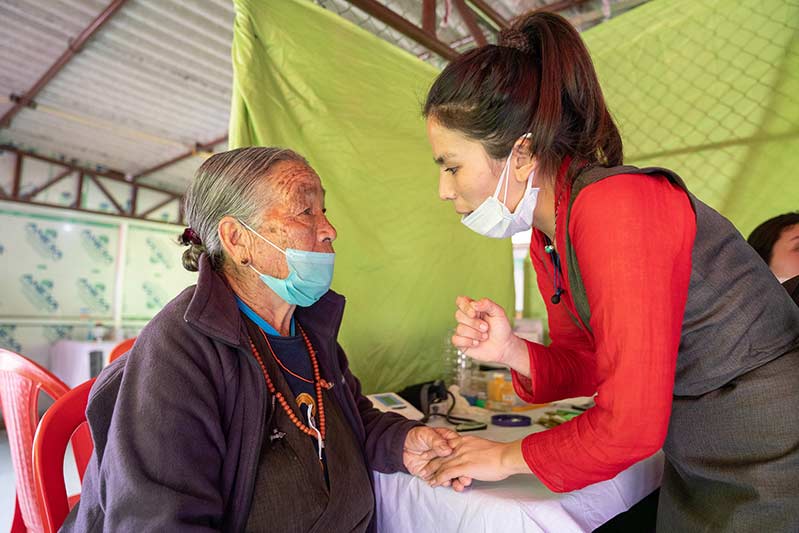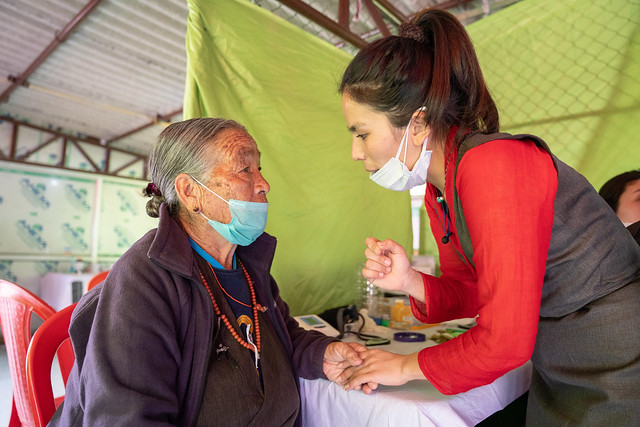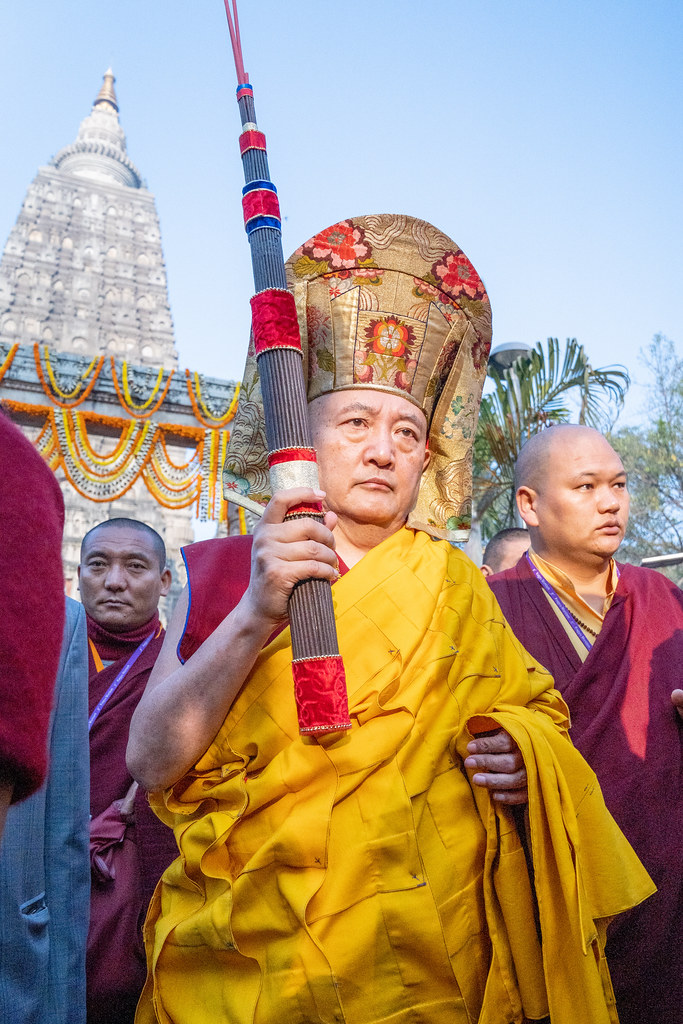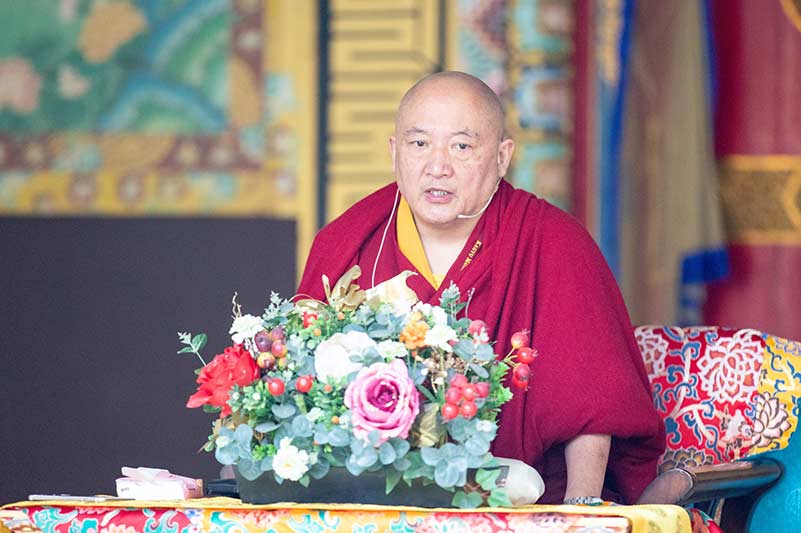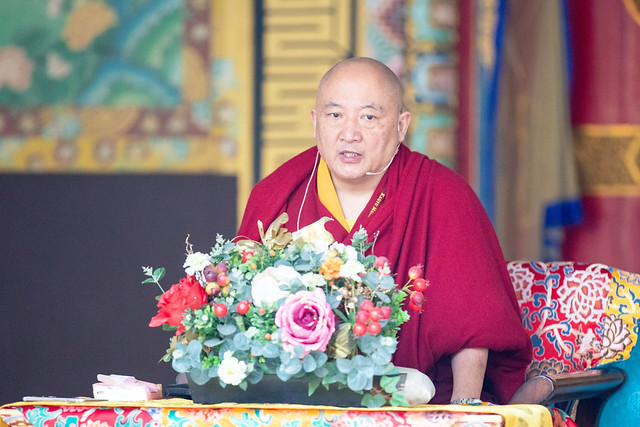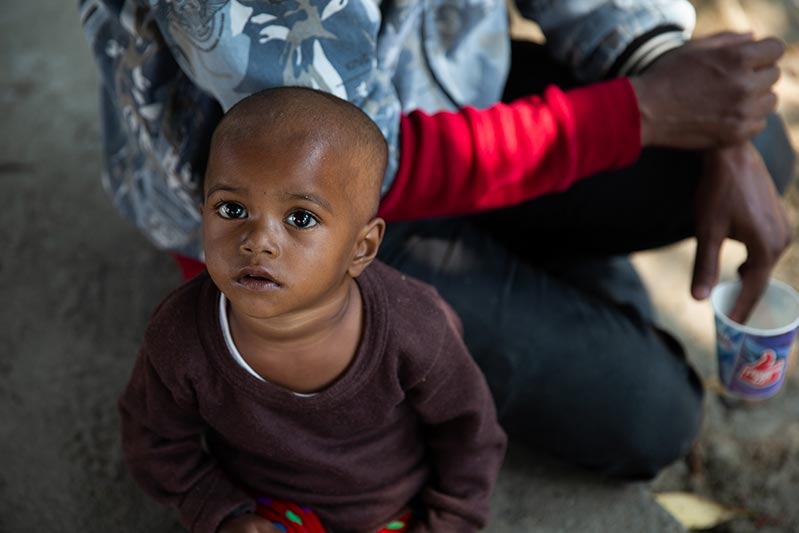
Tergar Monastery, Monlam Pavillion,
February 7, 2020
The Arhat Procession and Offerings to the Sixteen Arhats is one of the highlights of the Kagyu Monlam Chenmo in Bodhgaya. Making offerings to the Arhats and giving alms is seen as a source of blessings particularly for laypeople, and, as a consequence, the number of people in the pavillion had swelled for the event. Overnight the stage area had been transformed. Fresh flowers had been placed in rows along the central tiers of the stage below the tormas and shalzes, two tables and chairs had been set on the platform below the Buddha—one for His Holiness the 17th Karmapa and one for HE Gyaltsab Rinpoche— and on the lower stage, a great black pagoda shrine had been assembled, with four double seats for the Arhats placed either side. In the auditorium, below the stage, an enormous empty cauldron awaited the offerings. A red carpet, strewn with flower petals and lined with golden marigolds, wound all the way back from the Monlam stage, out of the main door of the pavillion, and along to Tergar Monastery main shrine room. [The route of the procession had been altered this year and now followed the path to Tergar shrine room behind the Monlam Pavilion rather than along the road.] At intervals, beautiful representations of the eight auspicious symbols— the parasol, golden fish, vase, utpala flower, conch, glorious knot, victory banner, and eight-spoked wheel— had been created from flower heads and petals. This was the sacred path prepared to honour the Arhats; everyone stepped gingerly around it, and Dharmapalas ensured that no one trespassed on it.
The Arhats commemorated in the procession are the sixteen disciples chosen by Shakyamuni Buddha and asked to remain in the world, protecting the Dharma until his teachings come to an end at the appearance of Maitreya, the next World Buddha. The tradition for the procession dates back to a practice of the Kagyu Garchen, the great encampment which travelled around Tibet with the Karmapas. The Garchen was like a village or small town, comprising thousands of followers and included a shedra, a thangka painting school, craftsmen, monastics and laypeople. During the time of the 7th Karmapa, a procession of the Sixteen Arhats, known as the chakkor, was held on the final day of the Monlam prayer festival. The 9th Karmapa added the Buddha and two of his disciples to the procession. This tradition came to an abrupt end when the Garchen was destroyed at the time of the 10th Karmapa by the Mongol warlord, Gushri Khan. However, the 15th and 16th Karmapas revived the tradition, holding the procession on the auspicious full-moon day in the first month of the Tibetan year.
In the Tibetan diaspora, the tradition was revived once more at the Bodhgaya Kagyu Monlam Chenmo by His Holiness the 17th Gyalwang Karmapa in January 2014, when he integrated it with the Alms Procession. At that time, he explained, “We’re inviting the Arhats to join us mainly in order to help the Dharma flourish. The Dharma teachings are the sole medicine, the sole salve for all sentient beings. It’s the only medicine to eliminate the sufferings of sentient beings.”
Before the procession began, those involved gathered inside Tergar shrine room, reciting prayers and meditating. Like ritual dance –Cham-the monks should maintain meditative awareness throughout the ceremony.
The masks and costumes that the Arhats wear are based on the Chinese tradition which was introduced into Tibet in the 10th century. This is the style reflected in a sketch of all sixteen arhats by His Holiness the 17th Karmapa. Each of the Arhats can be distinguished by their facial features, the objects they are holding and the size of their retinue. In the Monlam procession, the number of monks in the retinue represents its actual size. Each monk in the retinue carries an alms bowl, supported by the palm of the left hand, and held by the right hand.
Today’s ceremony was especially significant because it was also the celebration of Bokar Yangsi Rinpoche’s ordination. In the early morning he had gone to the Mahabodhi Stupa to receive the barma rabchung vows [preliminary ordination] from HE Goshir Gyaltsab Rinpoche, assisted by HE Zurmang Gharwang Rinpoche and Yongey Mingyur Rinpoche.
Just before seven o’clock, the senior Rinpoches arrived back from the Mahabodhi Stupa and the assembly saw Bokar Yangsi Rinpoche in monk’s robes for the first time. The Rinpoches took their seats in the front row of the sangha, and HE Goshir Gyaltsab Rinpoche took his seat on the stage, flanked by gelongs arrayed across its tiers. Immediately on arrival, Gyaltsab Rinpoche gave the Sojong vows, then the first part of the Monlam —the three daily observances recited in Sanskrit— began. After these prayers concluded, Bokar Yangsi Rinpoche stepped up onto the stage, prostrated three times, and made a ku-sung-thuk [body, speech and mind] mandala offering to the 17th Karmapa’s throne; His Holiness was represented by his heavily-embroidered silk brocade dagam.
As the prayers from the first session of the Monlam continued, sweet rice and Tibetan butter tea were served in celebration of Rinpoche’s ordination. The Minister of Religion and Rural Development of the State of Sikkim, Sri Sonam Lama, with his entourage, were honoured guests. The Minister plays an influential role in the government of Sikkim and has been of great assistance to the Karma Kamtsang: he arranged for the bukdam to be brought from Dharamsala to Rumtek Monastery, and he has been instrumental in obtaining permission for the 17th Gyalwang Karmapa to visit Sikkim.
As the Arhat procession set out from Tergar Monastery, everyone began to sing the first section of the Prostrations and Offerings to the Sixteen Arhats. Gyaltsab Rinpoche wore his red crown, Zurmang Gharwang the red ceremonial hat of the Kagyu, and the two front rows of sangha— monks and nuns—donned yellow tsesha. The great screens on either side of the Monlam stage showed the procession’s progress. One by one the Arhats and their entourages emerged from Tergar shrine room to make their way in a measured pace to the Monlam Pavillion, their route lined by devotees proferring katas, incense and flowers.
Within the Pavillion, the musicians drummed steadily, played a continuous heralding note on their gyalings and rang their bells. Monks circulated inside swinging censers of Tibetan incense to purify the environment for the Arhats. Gyaltsab Rinpoche and the other Rinpoches stood out of respect to receive them.
Each Arhat was followed by a line of monks bearing alms bowls to symbolise his entourage, and the procession concluded with a decorated electric cart, a twenty-first century chariot for the standing Buddha image. The Arhats took their seats on the stage and the golden Buddha statue was placed carefully into the black pagoda.
To honour his ordination, Bokar Yangsi Rinpoche and his Labrang were the first to make offerings great bowls of fruit- to the Arhats, to His Holiness’ throne and to the senior Rinpoches. The other Labrangs and the Kagyu Monlam organisation followed.
The Arhats left the stage and returned in their ordinary robes.
Now it was the turn of the general public. While the congregation chanted Namo Shakyamunaye, alternating with the Refuge Prayer, laypeople queued to make their offerings which were placed in the huge cauldron. It filled quickly and was emptied again and again as thousands of devotees made their offerings—the line stretched around the outside of the pavillion and as people made space, having made their offerings, others joined the line. At 10.00am the Rinpoches left once more for a private ceremony in Tergar Shrine Room followed by a reception for Bokar Yangsi Rinpoche.
They returned later to join the final part of the morning’s programme, the special lunch for gelongs, held on the Monlam stage.



































